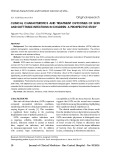
Skin and soft tissue infections
-
This study addresses the elevated prevalence of skin and soft tissue infections (SSTIs) within the pediatric demographic, necessitating a comprehensive inquiry into their varied clinical manifestations. The primary objectives involve the assessment of clinical and laboratory characteristics of SSTIs in children and an exploration of their correlation with treatment efficacy.
 5p
5p  vinatisu
vinatisu
 29-08-2024
29-08-2024
 1
1
 0
0
 Download
Download
-
Antimicrobial Therapy for Selected Settings For uncomplicated skin and soft tissue infections, the use of oral antistaphylococcal agents is usually successful. For other infections, parenteral therapy is indicated. S. aureus endocarditis is usually an acute, life-threatening infection. Thus prompt collection of blood for cultures must be followed immediately by empirical antimicrobial therapy. For S. aureus native-valve endocarditis, a combination of antimicrobial agents is often used.
 7p
7p  colgate_colgate
colgate_colgate
 21-12-2010
21-12-2010
 62
62
 3
3
 Download
Download
-
Skin and Soft Tissue Infections S. aureus causes a variety of cutaneous infections. Common predisposing factors include skin disease, skin damage (e.g., insect bites, minor trauma), injections (e.g., in diabetes, injection drug use), and poor personal hygiene. These infections are characterized by the formation of pus-containing blisters, which often begin in hair follicles and spread to adjoining tissues. Folliculitis is a superficial infection that involves the hair follicle, with a central area of purulence (pus) surrounded by induration and erythema.
 6p
6p  colgate_colgate
colgate_colgate
 21-12-2010
21-12-2010
 630
630
 3
3
 Download
Download
-
Harrison's Internal Medicine Chapter 129. Staphylococcal Infections Staphylococcal Infections: Introduction Staphylococcus aureus, the most virulent of the many staphylococcal species, has demonstrated its versatility by remaining a major cause of morbidity and mortality despite the availability of numerous effective antistaphylococcal antibiotics. S. aureus is a pluripotent pathogen, causing disease through both toxin-mediated and non-toxin-mediated mechanisms.
 5p
5p  colgate_colgate
colgate_colgate
 21-12-2010
21-12-2010
 86
86
 3
3
 Download
Download
-
Harrison's Internal Medicine Chapter 135. Gas Gangrene and Other Clostridial Infections Definition Bacteria of the genus Clostridium are gram-positive, spore-forming, obligate anaerobes that are ubiquitous in nature. There are 60 recognized species of clostridia, many of which are generally considered saprophytic. Some of these species are pathogenic for humans and animals, particularly under conditions of lowered oxidation-reduction potential. Infections associated with these organisms range from localized wound contamination to overwhelming systemic disease.
 5p
5p  colgate_colgate
colgate_colgate
 21-12-2010
21-12-2010
 79
79
 4
4
 Download
Download
-
Necrotizing Fasciitis This infection may arise at a site of minimal trauma or postoperative incision and may also be associated with recent varicella, childbirth, or muscle strain. The most common causes of necrotizing fasciitis are group A streptococci alone (Chap. 130) and a mixed facultative and anaerobic flora (Chap. 119). Diabetes mellitus, peripheral vascular disease, and intravenous drug use are associated risk factors.
 5p
5p  thanhongan
thanhongan
 07-12-2010
07-12-2010
 80
80
 3
3
 Download
Download
CHỦ ĐỀ BẠN MUỐN TÌM


















